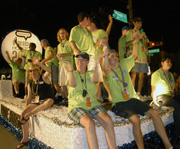Houston Pride: A Timeline
Timeline
 June 27, 1969
June 27, 1969
New York City police raid the gay bar the Stonewall Inn, arresting and harassing patrons, as was common at that time. For the first time, patrons led by transgenders, historians believe, resist arrest by throwing trashcans, coins, and, according to legend, high heels. The Stonewall Inn is set ablaze. Many attribute the reaction to GLBT grief following the recent death of gay icon Judy Garland. In its coverage of the event, CBS News called the incident “The Hairpin Drop Heard ‘Round The World.”
1970
“Remember Stonewall” vigils, the first lesbian and gay Pride events, are held in June in Los Angeles and Chicago. Gay Liberation Front, an activist group, is one of the first gay activists groups in the nation.
1972
Houstonians participate in Dallas Gay Pride Parade.
1973
Representatives from the Houston Gay Political Coalition, a precursor to the Houston GLBT Political Caucus, appear before Houston City Council. Coalition members unsuccessfully request the last week in June be declared Gay Pride Week.
1976
Houston’s first Gay Pride Parade, an informal march, is held downtown during the afternoon of June 20, sponsored by the University of Houston’s Gay Activist Alliance. Nearly 300 people attend.
1977
A planned Pride Parade is cancelled due to a lack of funds. However, an estimated 12,000 gays, lesbians, bisexuals, transgender individuals, and friends respond to a Texas State Bar Association-sponsored appearance by Ania Bryan, the virulently anti-gay Florida orange juice spokesperson and former Miss America. The peaceful march, pulled together by Ray Hill and now-deceased Houston activist Gary Van Ooteghem, proceeds down Smith and Louisiana streets, ultimately encircling the Hyatt Regency Houston, where Bryant is appearing.
1978
Houston formally celebrates its first Gay Pride Week in June with a full schedule of political and social events, including Town Meeting I, held at the AstroArena, a hall adjacent to the Astrodome in what is now Reliant Park. Nearly 3,500 people attend. As a result, integral local service groups, including Gay & Lesbian Switchboard Houston, Montrose Sports Association, and the Montrose Counseling Center, are born.
1979
Houston’s first official Gay Pride Parade is held on Westheimer, led by grand marshal Thelma Hansel, also known as “Disco Gramma,” at the end of June. Themed “United We Stand,” the parade is followed by a rally at Spotts Park, where 5,000 community members enjoy music, speeches, dancing, and fireworks.
1980
With the theme “Proud to Be,” Pride Week grows to a 10-day celebration. The first Pride Guide , highlighting related events, community resources, and local gay and lesbian history, is published. The parade starts in the parking lot of The Old Plantation, a club located on Kipling at the time. A Randall’s grocery store now occupies that site.
1987
Gay Pride Week is re-named Gay/Lesbian Pride Week.
1988
Themed “Rightfully Proud,” the parade honors its first honorary grand marshals, Sharon Kowalski (the Minnesota lesbian at the center of a case over her medical care, following an automobile accident, between her partner Karen Thompson and her parents) and slain gay rights leader and San Francisco city supervisor Harvey Milk.
1993
PFLAG Houston is named first organization grand marshal to the Pride Parade.
1994
Pride Parade is themed “HouStoneWall 25,” recognizing the 25th anniversary of the Stonewall Rebellion. Following the parade, a community festival returns to Spotts Park on Memorial Drive.
1995
City Council approves the hanging of pink triangle banners along both sides of Westheimer through Montrose to commemorate Pride festivities in June.
1997
An estimated crowd of 70,000 watches the first nighttime Pride Parade, themed “Unified, Diversified, Electrified,” roll along Westheimer on June 28. More than 100 contingents participate in the parade.
1999
A record-breaking crowd of 100,000 people lines Westheimer to watch the parade. For the first time, a mirrored, 8 1/2-foot-diameter disco ball is suspended over the intersection of Montrose Boulevard and Westheimer.
2001
Rainbow banners replace pink triangle banners along the Westheimer Parade route.
2003
Commemorating the 25th anniversary of the Houston Pride Parade, all previous grand marshals lead the parade. Tyrone Garner and John Lawrence, the petitioners in Lawrence v Texas, the case in which state sodomy laws were declared unconstitutional by the U.S. Supreme Court, are named honorary grand marshals.
2005
The Pride Festival returns to Montrose.
2007
Potentially, the GLBT Pride Parade and Festival will be the final celebration to be held in Montrose in June.
SEE ALSO:
Past Pride Parade Marshals’ Opinions
Put in your two cents










